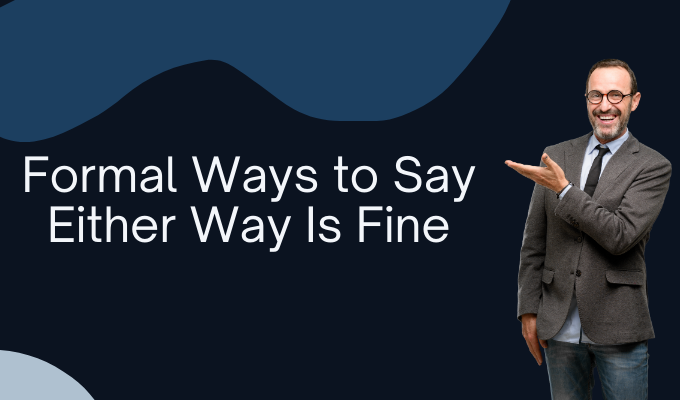Have you ever been in a situation where you needed to let someone know that you’re okay with any option, but you wanted to sound professional and polite?
We’ve all been there! In the world of emails, meetings, and business conversations, finding the right words can be tricky. You don’t want to come off as too casual, especially in a formal setting.
That’s why it’s so important to have a few go-to phrases up your sleeve. Instead of just saying “Either way is fine,” which can sound a bit too informal, there are plenty of more polished and professional ways to express the same idea.
This can help you maintain a courteous and respectful tone, which is crucial in professional communication. In this article, we’ll explore 10 formal ways to say either way is fine. These alternatives will help you sound more refined and confident, no matter the context.
Let’s explore and discover the perfect phrases to improve your professional language skills!
The Importance of Formal Language in Professional Settings
Using formal language in professional settings is crucial for several reasons. First, it helps maintain professionalism and respect your colleagues, clients, and partners.
When you communicate with care, it reflects positively on you and your organization. For example, instead of casually saying, “I’m okay with anything,” you might say, “I am flexible with either option.” This slight change in phrasing can make a big difference.
Formal language also ensures clarity. When you use precise terms, there’s less room for misunderstandings. Imagine you are in a business meeting, and someone proposes two different plans.
Saying “Either way is fine” might leave them wondering if you’ve considered both options. However, a phrase like “Both options are acceptable to me” conveys that you’ve given it thought and are truly okay with either choice.
Finally, the tone is essential. The right tone can make you seem cooperative and agreeable. It’s all about showing you are a team player without sounding indifferent.

Formal Ways to Say Either Way Is Fine
Phrase 1 – “I am flexible with either option.”
This phrase is a great way to convey that you are open to different possibilities without sounding indifferent. It’s particularly useful in emails and meetings where decisions need to be made.
For instance, if someone asks you about scheduling a meeting, you might say, “I am flexible with either option, so please choose what works best for you.”
This shows that you are considerate and accommodating.
Phrase 2 – “Both options are acceptable to me.”
“Both options are acceptable to me” is a straightforward and clear way to show that you don’t have a preference. It works well in both written and spoken communication.
For example, if your team is deciding between two project plans, you can say, “Both options are acceptable to me, so I’m happy to go with whatever the team decides.”
This indicates that you trust the team’s judgment and are supportive.
Phrase 3 – “I am open to either suggestion.”
When you want to show that you are open-minded and receptive to different ideas, “I am open to either suggestion” is a perfect choice. It’s great for collaborative discussions.
For instance, if a colleague proposes two ways to approach a task, you could respond, “I am open to either suggestion, so let’s discuss which might work best.”
This shows that you value their input and are ready to discuss further.
Phrase 4 – “I have no strong preference.”
Sometimes, you need to communicate that you truly don’t have a strong preference between two options. Saying “I have no strong preference” is a clear and formal way to do this.
For example, if you are asked to choose between two dates for a meeting, you might say, “I have no strong preference regarding the meeting date, so please choose what works best for everyone.”
This makes it clear that you are flexible and easygoing.
Phrase 5 – “Either option works for me.”
“Either option works for me” is a concise and effective way to communicate that you are fine with any choice. It’s especially useful when quick decisions are needed.
For instance, if someone asks whether you prefer a morning or afternoon meeting, you can say, “Either option works for me, so feel free to decide based on your schedule.”
This shows that you are accommodating and considerate of others’ time.
Phrase 6 – “I am equally comfortable with both choices.”
This phrase is particularly useful in formal discussions. It conveys that you are completely neutral and comfortable with any decision.
For example, if you are deciding between two locations for a conference, you might say, “I am equally comfortable with both choices, so please select the one that you think is best.”
This shows that you are supportive and trusting of others’ decisions.
Phrase 7 – “I can accommodate either option.”
When dealing with logistical decisions, “I can accommodate either option” is a great phrase to use. It shows that you’re flexible and willing to adapt.
For example, if someone asks whether a project deadline should be extended, you could respond, “I can accommodate either option, so let’s choose what’s most feasible.”
This demonstrates your adaptability and cooperative spirit.
Phrase 8 – “Both options have my approval.”
This phrase is ideal when you need to convey that you are okay with either choice in a decision-making authority role.
For example, if your team proposes two different strategies, you can say, “Both options have my approval, so please proceed as you see fit.”
This shows that you trust your team and are confident in their judgment.
Phrase 9 – “I am agreeable to either alternative.”
In negotiations or formal agreements, “I am agreeable to either alternative” is a perfect phrase to use. It indicates that you are open to any proposed solution.
For instance, if you are discussing contract terms and there are two options on the table, you might say, “I am agreeable to either alternative proposed in the contract.”
This shows your willingness to cooperate and find a mutually beneficial solution.
Phrase 10 – “I see no issue with either choice.”
When troubleshooting or planning, “I see no issue with either choice” is a helpful phrase. It communicates that you don’t foresee any problems with the options presented.
For example, if you are planning a project timeline and there are two possible schedules, you could say, “I see no issue with either choice for the project timeline, so let’s proceed with the one that works best for the team.”
This shows that you are supportive and confident in the team’s abilities.

The Contexts for Using Formal Alternatives
Knowing when to use formal alternatives to “either way is fine” is just as important as knowing the phrases themselves. Here are some common contexts:
- Business Meetings: During meetings, decisions often need to be made. Instead of a casual response, using a formal phrase shows you are engaged and considerate. For example, “I can accommodate either option for our meeting schedule” is much more professional.
- Emails and Correspondence: Written communication leaves a lasting impression. In emails, especially with clients or higher-ups, saying “I am equally comfortable with both choices” can show professionalism and respect.
- Negotiations: Flexibility can be a strength in negotiations. Saying “I am open to either suggestion” during a negotiation shows you are willing to work towards a mutual agreement.
- Presentations and Reports: When presenting options, showing neutrality can be beneficial. Phrases like “Both options have my approval” can be used to communicate this effectively.
In a Nutshell
Having a variety of formal ways to say “either way is fine” can greatly enhance your professional communication.
These phrases help maintain professionalism, clarity, and a positive tone in your interactions.
By using these alternatives, you can ensure that your communication is respectful, polished, and effective.
Remember, it’s all about showing flexibility and cooperation while maintaining a formal tone.
So next time you need to convey that you are okay with any option, try out one of these phrases and see how it elevates your communication!






